Post-polio syndrome is a condition that affects the survivors of polio decades after the acute illness of poliomyelitis. The major symptoms are pain, fatigue and weakness. New weakness is considered the hallmark of post-polio syndrome. Less commonly, survivors may have new sleep/breathing/swallowing problems and some survivors may also experience muscle atrophy or muscle wasting.
Criteria for Diagnosis
The criteria for diagnosing post-polio syndrome have evolved over the last 20 years. The United States National Institute of Neurological Disorders and Stroke (NINDS) lists the following Criteria for diagnosis of post-polio syndrome*
- Prior paralytic poliomyelitis with evidence of motor neuron loss, as confirmed by history of the acute paralytic illness, signs of residual weakness and atrophy of muscles on neuromuscular examination, and signs of nerve damage on electromyography (EMG). Rarely, persons have subclinical paralytic polio, described as a loss of motor neurons during acute polio but with no obvious deficit. That prior polio now needs to be confirmed with an EMG. Also, a reported history of nonparalytic polio may be inaccurate.
- A period of partial or complete functional recovery after acute paralytic poliomyelitis, followed by an interval (usually 15 years or more) of stable neuromuscular function.
- Gradual onset of progressive and persistent new muscle weakness or abnormal muscle fatigability (decreased endurance), with or without generalized fatigue, muscle atrophy, or muscle and joint pain. Onset may at times follow trauma, surgery, or a period of inactivity, and can appear to be sudden. Less commonly, symptoms attributed to PPS include new problems with breathing or swallowing.
- Symptoms that persist for at least a year.
- Exclusion of other neuromuscular, medical, and orthopedic problems as causes of symptoms.
*Modified from: Post-Polio Syndrome: Identifying Best Practices in Diagnosis & Care. March of Dimes, 2001.
Post-Polio Health International recommends that all polio survivors receive consistent, basic medical evaluations. If a survivor's symptoms are not explained and alleviated by general medical approaches and the symptoms persist or worsen, a referral is in order. In many countries, a physiatrist (physical medicine and rehabilitation specialist) or a neurologist can conduct a neuromuscular evaluation to establish a diagnosis and to recommend a management plan. In other countries, an orthopedist, a specialist in treating disorders of the musculoskeletal system, is typically the physician who treats polio survivors.
Because there is no cure for post-polio syndrome, health professionals recommend a management plan that is designed specifically for the polio survivor. The plan may include a variety of recommendations. The list below mentions just a few.
- bracing to support weak muscles and/or over-used and stretched joints
- use of canes and crutches to relieve weight on weak limbs and to prevent falls
- customized shoes to address unequal leg lengths, which can be the cause of back pain and requires extra energy to walk
- use of wheelchairs or motorized scooters for long-distance
- recommendation of weight loss
- recommendation of specific select exercises to avoid disuse weakness and overuse weakness
- use of a breathing machine at night to treat underventilation
Individual polio survivors can help them themselves by "listening" to their bodies and pacing their activities. With time, survivors can learn when to stop before they become over fatigued. Many survivors report feeling better after adapting assistive devices and "slowing down" by interspersing activities with brief rest periods.
What causes post-polio syndrome? In the early years, there was some speculation that the cause might be a "recurrence" of polio or reactivation of the poliovirus, which is not the case. The generally accepted theory is best demonstrated by the following diagrams.**
1. Degeneration of Nerve cells (Neurons) during Acute Polio
|
Diagram of healthy spinal cord section with nerve cells (motor nerve cells) branching to muscles. |
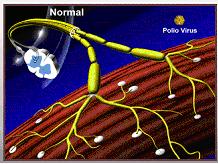 |
|
During acute polio infection the nerve cell is invaded by poliovirus. |
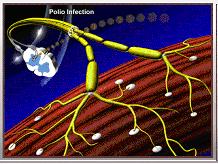 |
|
In this diagram, one of the nerve cells has been infected by the poliovirus, while its neighbor has not. |
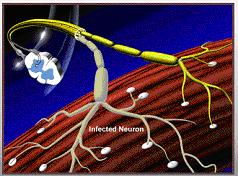 |
|
Destruction of the infected nerve cells results a lack of nerve supply to the muscles. |
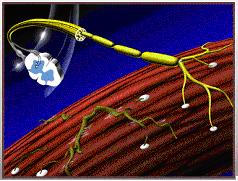 |
|
If this process occurs on a large enough scale, it can result in loss of muscular function, and can cause weakness or paralysis. |
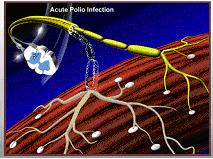 |
2. Recovery From Acute Paralytic Polio
| Immediately following paralytic polio, surviving motor nerve cells in the brain stem and spinal cord extend new branches to re-connect the nerve cell to the muscle. These are called sprouts. | 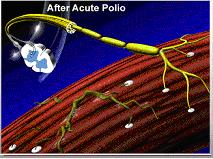 |
|
In this diagram, the new sprouts are now capable of triggering contraction in the muscles and muscle function can be partially or fully regained. |
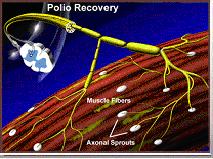 |
|
Thus, many motor nerve cells end up supplying several times the number of muscle fibers they would normally supply. |
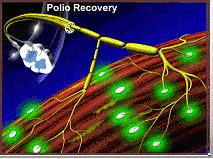 |
3. Mechanism of Post-Polio Syndrome
|
Wiechers and Hubbell proposed that these new sprouts are not indefinitely stable...Wiechers, D. & S.L. Hubbell. 1981. Late changes in the motor unit after acute poliomyelitis. Muscle & Nerve 4: 524-528. |
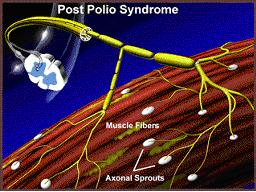 |
|
...but rather degenerate over time due to an "overexertion" phenomenon resulting once again in muscle fibers that no longer contract, which a survivor recognizes as new weakness and loss of function. |
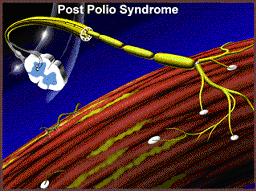 |
**Modified from: Post-Polio Syndrome: A New Challenge for the Survivors of Polio©, Post-Polio Health International (1997)
A Few Words about Definitions
Technically, post-polio syndrome is NOT the same condition as Post-Polio Sequelae/ the late effects of polio. Post-polio syndrome is usually considered a specific NEW condition. A diagnosis of exclusion is used to determine if a patient has PPS. This means if a survivor of polio is found to have osteoarthritis, for example, that is what the diagnosis will be – osteoarthritis, not PPS. Because of this, the number will be lower for post-polio syndrome than when the number is referring to post-polio sequelae or the late effects of polio.
Twenty-five to forty percent of polio survivors experience post-polio syndrome (depending on the study).
As many as 70% of polio survivors are said to have Post-Polio Sequelae or late effects of polio.
Don't Get Hung up on Definition
Polio conditions exist along with other diseases. Therefore, it is important not to get hung up on definition but to encourage polio survivors and their medical professionals to work together to find the causes of any symptom and provide treatment, i.e., medication for hypothyroidism, hypertension, diabetes, irritable bowel syndrome, etc., etc. An evaluation that too quickly determines that prior polio is the sole cause deprives survivors of potential treatments.
